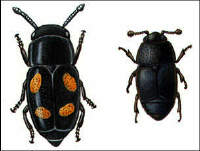Lions and Tigers and Oak
Wilt…Oh my!
Dr. Jennifer Fritz, PhD in Botany, UT
In all seriousness, there
is a threat to our wonderful neighborhood about which we who walk
the tree-lined streets are aware . It is not burglaries or teen-age
drivers or loose dogs. Oak wilt has already caused major destruction
to the oak trees in Castlewood Forest in the past and is sadly
on the move again.
Oak wilt is an aggressive disease caused by a fungus (Ceratocystis
fagacearum), first identified in 1944, that affects and kills
many species of oaks (Quercus spp.), predominantly the red oak
and live oak. It is one of the most serious tree diseases in the
eastern United States, killing thousands of oaks each year in
forests, woodlots, and home landscapes. Oak wilt is prevalent
throughout much of the Mideastern US, including Texas.
The oak wilt fungus moves from tree to tree in two ways: transported
underground through the roots or overland by beetles. The majority
of new tree infections occur as a result of the fungus moving
from an infected tree to a nearby healthy tree through connected
root systems. The roots of trees in each oak group commonly graft
to roots of other trees in the same group, forming a continuous
under-ground network. When one tree in a group becomes infected
and dies, the fungus spreads through the connected root systems,
killing more trees. A continuous root system often does occur
between Texas live oaks and red oaks in mixed stands.
 |
Upper Pathway: Long distance spread
of oak wilt occurs when nitidulid beetles carry spores
of the fungus from spore mats on infected trees to wounds
on healthy trees, causing infection and death of the tree.
Time from infection to mortality may be very short for
red oaks and Texas live oak, or many years for members
of the white oak group.
Lower Pathway: Local spread
of oak wilt occurs when the fungus travels through the interconnected
roots of infected and healthy trees. |
Depending upon soil type and the mix of tree species in a forest
or yard, infection of healthy trees through root grafts can occur
at some distance (up to 100 feet or more) from an infected tree.
Some oak species, including northern pin oak and Texas live oak,
often grow in large groups of similar-aged trees that share a
common root system. Such situations can lead to rapid expansion
of oak wilt centers if even one tree in the group becomes infected.
The fungus responsible for oak wilt may produce spore mats in
dead trees, which are compact masses of spore-producing fungal
material. These mats form just under the bark, in contact with
both the bark and the infected sapwood of the tree. Oak wilt spore
mats emit a strong fruity or wine-like odor that attracts many
different species of nitidulid beetles also known as sap beetles.
As they feed on or tunnel through the spore mats, nitidulid beetles
often accumulate fungal spores on the surface of their bodies.
New infection can also occur if the fungal spores are carried
from an infected tree to a fresh wound on a healthy tree by an
insect.
 |

|

Nitidulid beetles are primarily responsible for
overland spread of oak wilt. |
Oak trees often sustain wounds caused by construction equipment,
storms, pruning tools, or vandalism. Fresh wounds usually leak
sap. The sap attracts insects, including nitidulid beetles that
have visited oak wilt spore mats. In Texas, mat formation occurs
at any time during the year, but is most common in late fall and
winter when the weather is cooler and wetter. In Texas, spore
mats are formed only on Texas red oak and blackjack oak, and never
on Texas live oak. For this reason, the red oaks are important
for establishing new infection centers in Texas.
Stay tuned for more articles regarding this topic. Symptoms, diagnosis,
treatment and neighborhood coordination are all topics and issues
that must be discussed and acted upon if we want to halt the spread
of this despicable plant disease in our lovely neighborhood.
Much of this article was adapted from the USDA web site:
http://www.na.fs.fed.us/spfo/pubs/howtos/ht_oakwilt/toc.htm










